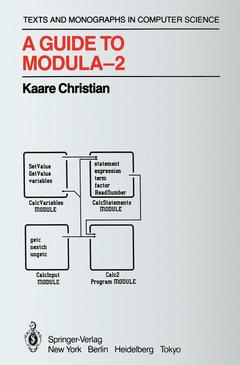A Guide to Modula-2, Softcover reprint of the original 1st ed. 1986 Monographs in Computer Science Series
Langue : Anglais
Auteur : Christian Kaare

Modula-2 is a simple yet powerful programming language that is suitable for a wide variety of applications. It is based on Pascal, a successful programming language that was introduced in 1970 by Niklaus Wirth. During the 1970's Pascal became the most widely taught programming language and it gained acceptance in science and industry. In 1980 Dr. Wirth released the Modula-2 program ming language. Modula-2 is an evolution of Pascal. It improves on the successes of Pascal while adding the MODULE - a tool for ex pressing the relations between the major parts of programs. In ad dition Modula-2 contains low-level features for systems program ming and coroutines for concurrent programming. Programming languages are important because they are used to express ideas. Some programming languages are so limited that certain ideas can't be easily expressed. For example languages that lac k floating point arithmetic are inappropriate for scientific com putations. Languages such as Basic and Fortran that lack recur sion are unsuitable for text processing or systems programming. Sometimes a programming language is useable for a certain appli cation but it is far from ideal. A good example is the difficulty of writing large programs in pure Pascal. Pascal is a poor language for large jobs because it lacks facilities for partitioning a program viii Preface 6< ; ~~~~er 0\ Sheet Metal Tube /" 0 (to Affix Eraser to Shaft) ~ Hollow Wooden Shaft A Lead Core Figure 1. An exploded diagram. into separate pieces that can be developed independently.
I Moving to Modula-2.- 1 Modula-2 and Pascal.- 2 Data in Modula-2.- 3 Control Flow in Modula-2.- 4 Procedures.- 5 Arrays.- II Modules.- 6 Local MODULES.- 7 Definition Modules.- 8 Implementation Modules.- 9 Common Global MODULES.- 10 Desk Calculator with Variables and Assignments.- III Advanced Data Types.- 11 Enumerations.- 12 Sets.- 13 Records.- 14 Dynamic Data.- 15 Procedure Variables.- IV Systems Programming.- 16 TYPE Relaxation.- 17 Programming Hardware.- 18 Coroutines.- 19 Device Drivers.- Appendices.- I. Modula-2’s Reserved Words.- II. Modula-2’s Standard Identifiers.- III. Modula-2’s Standard Functions.- IV. Standard PROCEDURES from SYSTEM.- V. Standard Coroutine PROCEDURES.- VI. Legal Modula-2 Operations.- VII. Strict TYPE Compatibility.- VIII. Assignment TYPE Compatibility.- IX. The ASCII Character Set.- X. Implementation Notes.- XI. Syntax Diagrams.- Modules.- Procedures.- Types.- Declarations.- Constants.- Variables.- Operators.- Statements.
Date de parution : 12-2012
Ouvrage de 436 p.
15.5x23.5 cm
Mots-clés :
Factor; Pascal; Programming language A; Sieve; Strings; programming language
© 2024 LAVOISIER S.A.S.



